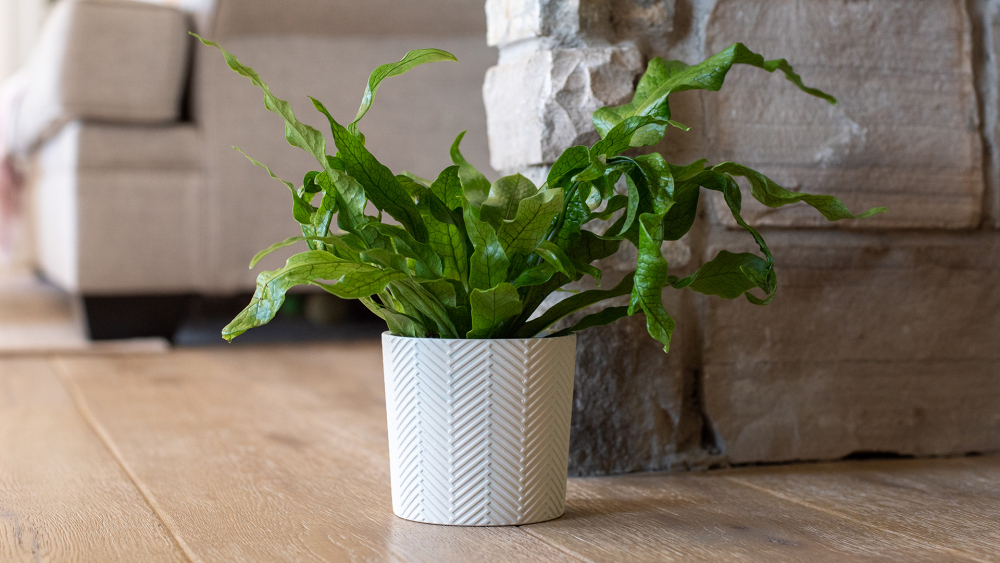
Crocodile Fern (Microsorum musifolium), known for its unique, crocodile-like textured leaves, is a fantastic addition to any indoor plant collection. This tropical beauty adds an exotic touch to your home and is relatively easy to care for once you understand its needs. Here’s everything you need to know to keep your Crocodile Fern thriving.
Before diving into care tips, it’s essential to know a bit about the plant’s natural habitat. The Crocodile Fern is native to the rainforests of Southeast Asia, where it thrives in warm, humid conditions. This background gives us clues on how to recreate similar conditions at home.
Crocodile Ferns prefer bright, indirect light. Direct sunlight can scorch their delicate leaves, causing them to lose their vibrant green color and develop brown spots. If possible, place your fern near an east-facing window where it can receive in-direct morning light. Alternatively, a north-facing window or a spot with filtered light will also work well.
Water your fern when the top inch of soil feels dry to the touch. Depending on your home’s humidity and temperature, this could be once a week or more frequently.
Water thoroughly until water drains out from the bottom of the pot. Ensure that the pot has good drainage to prevent water from sitting at the base. If watering into a pot without drainage holes, be sure to discard any excess water after watering your plant to prevent root rot.
Since Crocodile Ferns love humidity, consider misting the leaves regularly or placing a humidifier nearby. You can also set the pot on a tray filled with pebbles and water to increase humidity around the plant.
A well-draining, rich potting mix is essential for Crocodile Ferns. A blend designed for ferns or a mixture of peat, perlite, and pine bark works well. Repotting is usually needed every 2-3 years or when the plant outgrows its current container. When repotting, choose a slightly larger pot with drainage holes to avoid water retention.
Crocodile Ferns thrive in warm, humid environments. Aim to keep your plant in a room where the temperature stays between 60-75°F (15-24°C). Avoid placing the fern near drafts, air conditioning vents, or heaters, as sudden temperature changes can stress the plant.
If your home tends to be dry, especially during winter, make an extra effort to boost humidity around your fern. Grouping plants together can also help create a more humid microenvironment.
Throughout the growing period (spring and summer), nourish your Crocodile Fern approximately every 4-6 weeks with an evenly balanced, water-dissolvable fertilizer. Dilute the fertilizer to half the recommended strength to avoid overfeeding, which can lead to salt buildup in the soil. In fall and winter, reduce feeding to once every 2-3 months, as the plant’s growth slows down.
To propagate a crocodile fern, the easiest method is through division. Gently remove the plant from its pot, locate the rhizomes (horizontal stems), and use a clean knife to divide them, ensuring each section has roots and a frond.
Replant the divisions in fresh, well-draining soil, water thoroughly, and keep them in a spot with bright, indirect light. Maintain high humidity by misting regularly. Alternatively, you can propagate via spores found on the undersides of mature fronds, though this method takes longer and requires careful humidity control for germination.
Pruning and Maintenance
Crocodile Ferns are relatively low-maintenance when it comes to pruning. Remove any yellow or damaged leaves to keep the plant looking its best. Regularly dusting the leaves with a damp cloth will also help keep the plant healthy and able to photosynthesize effectively.
Even with the best care, Crocodile Ferns can face some issues. Here’s how to address common problems:
Brown Tips or Edges: This is often a sign of low humidity or inconsistent watering. Increase humidity and ensure you’re watering the plant correctly.
Yellowing Leaves: Overwatering is a common cause of yellow leaves. Allow the soil to dry out slightly before watering again, and check that the pot has proper drainage.
Pests: Crocodile Ferns can sometimes attract pests like spider mites or scale. Clean the leaves using a mixture of water and gentle soap, or apply an insect-killing soap to handle infestations.
Yes the Crocodile Fern is considered pet safe by the ASPCA
With the right care, your Crocodile Fern can become a lush, vibrant part of your indoor garden. By paying attention to its light, water, and humidity needs, you’ll be rewarded with a stunning plant that brings a touch of the tropics into your home. Whether you’re a seasoned plant parent or new to the world of indoor gardening, the Crocodile Fern is a delightful and manageable addition to any collection. Happy growing!